 The Snader telescription Sabre Dance (1950) features the last incarnation of the "Comedian Harmonists" renamed Jack Cathcart's Continentals. The Snader telescription Sabre Dance (1950) features the last incarnation of the "Comedian Harmonists" renamed Jack Cathcart's Continentals.
They dress in white dinner jackets & ties & look sophisticated at first glance, but behave like bratty children.
The leader of the five guys, I presume Jack, nervously introduces the number, then begins to whistle (surprisingly well) the ridiculous tune to Khachaturian's "Sabre Dance."
The rest of the guys stand behind him playing a game of poker. Eventually they put in their chorus of snotty noises, "doo-dooing" in falsettto, la-la-laing, playing with a yoyo, making faces. It's a ridiculous little film that must've held startled children rapt in its day, better than cartoons.
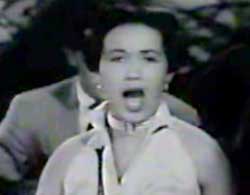 The Bando Da Lua Boys, a quintet, star in the Snader telescription Brazil (1950), which they sing in Portuguese. The Bando Da Lua Boys, a quintet, star in the Snader telescription Brazil (1950), which they sing in Portuguese.
The guys are playing two guitars, a gourd rattle, & a tambourine. They're quite good at what they're doing, a lively little performance.
Halfway through, an exotic beauty in flouncy dress comes center stage to sing the lyrics, this time in English. This is forgotten vocalist Carmen Lopez, who somehow didn't even rate a credit on the title card for this Snader.
She finishes her part & leaves the stage so that the Bando De Lua Boys can close with the Portuguese lyrics. All very appealing.
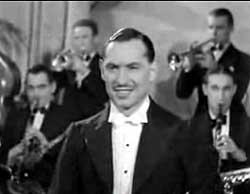 The introducing narrator heard on many Pathetone short-short films calls this "a session of swing & sway. Let it go!" & indeed Earl Carroll & His Radio Band (1938) are off & going. The introducing narrator heard on many Pathetone short-short films calls this "a session of swing & sway. Let it go!" & indeed Earl Carroll & His Radio Band (1938) are off & going.
The bandleader is not to be confused with Earl "Speedo" Carroll of the Coasters & the Cadillacs, who was only one year old when the British guy made this Pathetone film.
It's a small orchestra of ten guys -- piano, slapbase, guitar, reeds, brass, & drum -- plus Earl conducting in his tux. Earl turns to face the camera for a momentary portrait, & we get lovely portraits of each section of the band as the arrangement progresses.
A lot of the Pathetone choices of orchestras to film had a real sweetness to them, & this is in keeping with that tendency. It's been a smile-winner even before the guitarist gets up & strolls front center to reveal just-as-cute lyrics:
"If the sky is looking cloudy/ And you're feeling kind of blue/ Now don't fret, get up & step/ Swing & sway/ Oh the sun will soon say howdy/ And be smiling down at you/ So don't brood, get in the mood/ Swing & sway..."
There'll be a horn solo in the closing instrumental, then it fades out smoothly. This is a nice New York swing from the British perspective, with even references to Park Avenue in the lyric.
Yet as is often the case with British swing bands, it's slightly behind the curve & has stronger connection to the '20s than the '30s. Which can be great, because by the time swing all began to sound like Glenn Miller & Benny Goodman imitators, the music was no longer as exciting. For Earl Caroll's band, the ever so slightly retro flavor is to its favor.
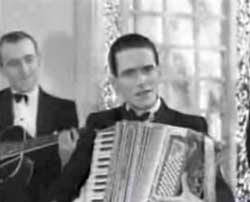 When it comes to the Venice-born classicist Annunzio Paolo Mantovani, whose recordings are still popular "dinner music" for upwardly mobile pretenders, who'd've expected he once put together a swing band?
When it comes to the Venice-born classicist Annunzio Paolo Mantovani, whose recordings are still popular "dinner music" for upwardly mobile pretenders, who'd've expected he once put together a swing band?
Well, he did so. He had been the best known concert violinist in England, but as early as 1931 he was conducting his own orchestra, soon recording popular tunes with classisist arrangements, & became an outright pop orchestra after the war.
His first swing band's awesomeness was captured on the Patheton short-short Mantovani & His Swinging Violins (1937).
Though mostly strings, the "strings" included jazz guitar, & additional instrumention -- sax, three clarinets, drums, piano -- & there's an accordion solo by Ronald Binge right off the bat, before the violins & cellos take over. Before finishing there'll be highlights for just about every instrument.
Mantovani has conducted with violin in hand, his bow as conductor's wand, but near the end he gives a rousing swing solo of his own. It's three minutes of excitement.
 We'll hear something more in keeping with Mantovani's expected sound of the era in a film a hair over two minutes. It's introduced with the text cards that read: Patheton now has the pleasure in presenting Mantovani, The Celebrated Violinist of Radio Rame & His Trio" (1938). We'll hear something more in keeping with Mantovani's expected sound of the era in a film a hair over two minutes. It's introduced with the text cards that read: Patheton now has the pleasure in presenting Mantovani, The Celebrated Violinist of Radio Rame & His Trio" (1938).
He's performing "Kashmiri Song" composed by Amy Woodforde-Finden for a poem by Laurence Hope (pseudonym of Adela Florence Nicolson). The poem first appeared in The Garden of Kama aka India's Love Lyrics (1901) which the public generally thought of as a translation of Indic origin though it was strictly British poetry.
The tune, too, is very British, but with striking classical appeal. Mantovani is accompanied by pianist & cellist, & they're stunningly good. Mantovani has dramatic posture, tortured expression, & beautiful hands which makes him great to see on film.
Though we don't get the poem/lyrics here, to anyone who knows the words, the close up of the violinist's hands goes to the line "Pale hands I loved beside the Shalimar/ Where are you now? Who lies beneath your spell?"
 Felix Mendelssohn & His Band (1938) is a small orchestra of ten men which was typical of bands of this era in England. It must've been kind of odd to be a popular tune bandleader with the same name as the classic composer of "The Wedding March," but I suppose Brits were used to it at the time. Felix Mendelssohn & His Band (1938) is a small orchestra of ten men which was typical of bands of this era in England. It must've been kind of odd to be a popular tune bandleader with the same name as the classic composer of "The Wedding March," but I suppose Brits were used to it at the time.
They have that "slightly retro" sound of still doing a style of arrangement common in America in the 1920s, with a quaintness that would make their performance suitable to early animated cartoons.
The song was as contemporary as they could select, "I Double Dare You" by Terry Shand & Jimmy Eaten published in 1937, already a great hit for Louis Armstrong who never got soaked up in the sameness of commercial swing bands, to the benefit of Felix's cover.
When British bands emulated Satchmo, it certainly never sounded like him, but it was ever so much better than emulating Beeny Goodman, which Goodman lovers will hate me for saying, but by the time the swing era ended way too much of it sounded like him, & that was due to commercialism not because it was more advanced than Sissle or Armstrong or Louis Jordan. To some degree the swing era ended because it stopped being innovative & cool.
In any case, I like the slightly retro flavor of mid-to-late '30s British bands. Felix stands rather still in white jacket conducting his guys in black suits. The drummer's kit is particulalry striking, a way bigger than average bass drum, & bells rather like a gamilon afixed on top.
Out strolls Paula Green to sing the lyrics: "I double dare you to sit over here/ I double dare you to lend me your ear/ Take off your high hat & let's get friendly/ Don't be a scare cat, say what do you care/ Can't you take a dare?
"I double dare you to kiss me & then/ I double dare you to kiss me again/ And if that look in your eye means what I'm thinking/ I double dare you to fall in love with me."
Paula does a great flapperish rendition; she's a pure delight. She leaves the stage when finished with the lyrics & we get a trumpet solo, a close-up of that amazing drum kit, a sax solo, & everyone together for a close. It's just great stuff, but then, I'm the sort who thinks Betty Boop had great arrangements, & you're wecome to your Goodman or Dorseys.
 The title card for this 1933 short-short reads "Now Pathetone presents another Band well known to Variety's broadcasting -- Percival Mackey & His Boys -- with solo dancer Monti Ryan." The title card for this 1933 short-short reads "Now Pathetone presents another Band well known to Variety's broadcasting -- Percival Mackey & His Boys -- with solo dancer Monti Ryan."
The slap bass is the biggest bass I ever saw in a band, but even so, could barely here it.
Percival bounces around conducting entertainingly, & the smallish band (of it looks like eleven in the bandstand) perform very charmingly with a lively trade-off between reeds & brass.
Suddenly an unidentified vocalist leaps into the frame to do a cheerful lyric: "Ah, millions of kisses & millions of smiles/ From someone or just someone I love/ That brings me the sunshine or flowers in May/ Why it's banished all the troubles that i get each day..."
 It's a very vaudevillian singing style -- or for England, Music Hall -- but as good as such lowbrow entertainment gets, worthy of the broadest smile. It's a very vaudevillian singing style -- or for England, Music Hall -- but as good as such lowbrow entertainment gets, worthy of the broadest smile.
And just as you think it couldn't be any more campily joyful, that humongous bass is lifted up by the musician who leaps down from the bandstand & manages to hold it like a guitar on steroids.
He plays a delightful instrumental together with guys on harmonica & & Indian cobra-taming mini-clarinet, interrupted for a momentary game of ring-around-the-rosies.
Lastly, out leaps showgirl Monti Ryan for some wild & crazy arm-tossing tap-dancing. She's a cutie, but it's odd with her bare moments in the film she got a title-card credit but the singer & slapbass guy didn't. Could it be because she was also known as Mrs. Percival Mackey?
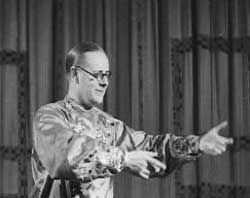 The full title card for this 1932 six-minute short reads "Both Sides of the Curtain, A topical peep at the Leicester Square Theater, London, 'Snapped' during an actual Performance."
The full title card for this 1932 six-minute short reads "Both Sides of the Curtain, A topical peep at the Leicester Square Theater, London, 'Snapped' during an actual Performance."
The orchestra is Percival Mackey & His Boys. The singer, who is also the orchestra's guitarist, is not identified on the film, but I'm thinking it's maybe Jimmy Messene. He sings "Dinah" in the old-timey Music Hall tradition, & does so splendidly in a romantic tenor.
Any film of Percivil in the act of conducting makes him look so amusing with his arms flapping up & down more like a drowning man than a bandleader. He's a bit of a dork, but in a cool way.
 After "Dinah," chorus girls rush out, & a text card alleges they were themselves famous, a troupe called J. W. Jackson's Girls. They do fairly standard chorus line dancing with lots of high kicks. After "Dinah," chorus girls rush out, & a text card alleges they were themselves famous, a troupe called J. W. Jackson's Girls. They do fairly standard chorus line dancing with lots of high kicks.
The gals are followed by comedian Freddie Forbes who tells one bad joke then introduces "three wonderful acrobats," the Three Bonos. With shouts of "hey! ho! hey!" the three Italian guys, one a big-bazoomed transvestite, stand on each others' shoulders, sommersault, do flips, claim to be breaking some assinine world record, & so on.
We're briefly taken "behind the scenes" into the backstage chaos to see dancers getting ready for their own acts, then return to the stage for "a bark or two from Morris Chester's famous dogs." Oh boy, a dog act!
A shitload of yappy little dogs in sweaters play soccer. I could've seen more of them, but in less than half a minute, another text card introduces the Four Admirals, a harmony group one at piano, one in chair with guitar, the other two standing. The rapid lyrics sound something like "We're going to pour that slavic on your face," but the song is actually "We're Going to Put that Smile Back On Your Face."
The Four Admirals are gone almost as swiftly as the dogs, supplanted by an act called "a four-legged frolic by the Hartmann Troupe." This is a slapstick routine between two guys trying to catch a horse which is two other guys in a horse costume. Something for the kiddies I suppose. Inexplicably, they're permitted more screen time than any other act after Percival Mackey.
It's all wrapped up with the entire cast hoofin' & singing a finale & curtain descending. In all, an interesting synoptic version of an evening of Music Hall entertainment, & how sad there's no longer any such thing.
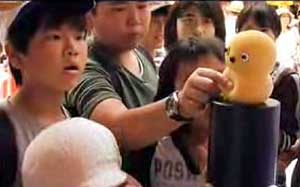 I first saw the indie rock band Spoon's video with the "dancing yellow robot" on the PBS science program Wired & thought to myself, "I bet that cute little bastard really is programmed to do that." I first saw the indie rock band Spoon's video with the "dancing yellow robot" on the PBS science program Wired & thought to myself, "I bet that cute little bastard really is programmed to do that."
As filmed it looked a little stop-motion-animation or fudged, but I just wanted to believe in that little guy, so I went to youtube & searched "dancing yellow robot" & found the Spoon video, as well as other less sophisticated films of the minimalist robot named Keepon.
He was designed by Hideki Kozima & programmed by Marek Michalowski to do, in essence, two things: First, dance to the beat of whatever music or drum-beat is played for it, & second, to be able to turn it's head & "look" in ways that despite the extreme minimalism of its face & motion nevertheless convey emotion, interest, or seeking behavior.
The little guy induces an emoitonal response in whoever watches him. The video Keepon Dancing to Spoon's Don't You Evah (2007) is only four minutes long, the length of the band's song, but it shows so much of how the world interacts with the robot, & we as video watchers can't help but feel the same draw toward him.
We first see him dancing to Spoon's song then there's a break in the music & Keepon turns his head to look at the Japanese programmer in lab coat, as if to ask, "Where'd the music go?" The lab worker picks up Keepon & a boombox & takes him into the streets of Tokyo, where we see pedestrians & children interacting with him.
Worked into the video almost undetectably until you look for them is the band Spoon performing on the street, or in an advertising sign board overhead, little cameo moments that are quite amusing but probably not noticed until the second or third time watching the film.
The heart of the film is people being drawn to the little robot as though it were a dog or a cat or a small child rather than a yellow blobby shape with eyes & a nose.
Toward the end there is a lot of interaction in a retail shop with a number of other robots (sometimes called the Beat-bots, as though they were an actual dance troupe). While the more elaborate robots dancing is amusing, it's not nearly as captivating as when a child seeing Keepon's motion wants to pinch him & see how real he is. The smiling faces of the many passersby he delights is ever so much more wonderful than Keepon dancing on a table with toy robots.
But it's all great, a nice little indie band's song that would make anyone dance, even a robot, it all just somehow makes lovely sense. And the contrast to the labworker taking Keepon about -- a labworker in glasses who never smiles or shows emotion -- is just one more layer of sophisticated humor inherent to this delightsome wee film.
copyright © by Paghat the Ratgirl
|








 It's a very vaudevillian singing style -- or for England, Music Hall -- but as good as such lowbrow entertainment gets, worthy of the broadest smile.
It's a very vaudevillian singing style -- or for England, Music Hall -- but as good as such lowbrow entertainment gets, worthy of the broadest smile.
 After "Dinah," chorus girls rush out, & a text card alleges they were themselves famous, a troupe called J. W. Jackson's Girls. They do fairly standard chorus line dancing with lots of high kicks.
After "Dinah," chorus girls rush out, & a text card alleges they were themselves famous, a troupe called J. W. Jackson's Girls. They do fairly standard chorus line dancing with lots of high kicks.